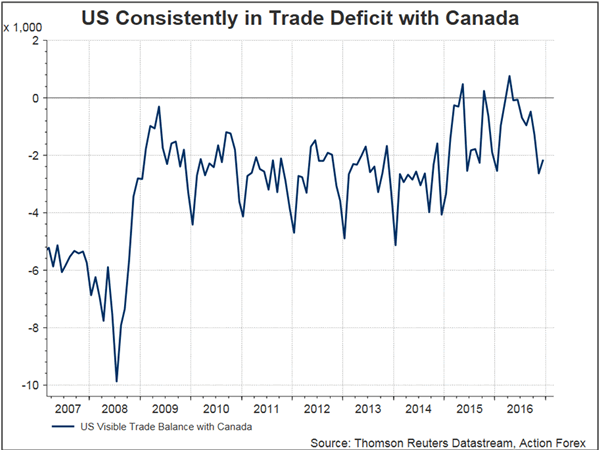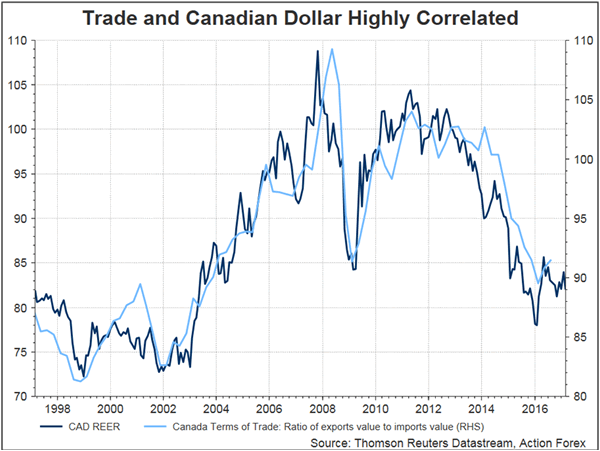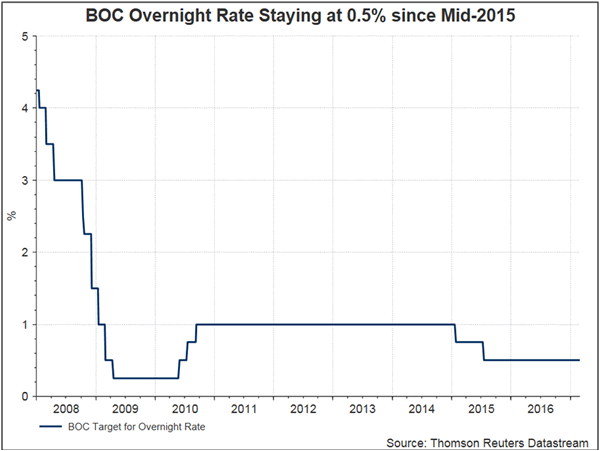As widely anticipated, BOC kept its monetary policy unchanged with the overnight rate at 0.5%, the Bank rate at 0.75% and the deposit rate at 0.25%. The central bank acknowledged that both global and domestic economic indicators were consistent with its projection of improving growth laid out in January. It also note Canadian growth in 4q16 came in ‘slightly stronger than expected’. However, policymakers maintained a cautious tone noting that ‘material excess capacity’ remained and that the central bank is ‘attentive to the impact of significant uncertainties weighing on the outlook’. Therefore, the risks and slacks in the economy justified leaving the policy rate at exceptionally low level.
In the discussions of economic developments, BOC remained wary that ‘exports continue to face the ongoing competitiveness challenges described in the January MPR’. It added that despite improvement in the employment situation, ‘subdued growth in wages and hours worked continue to reflect persistent economic slack in Canada, in contrast to the US’. The central bank also reiterated its vigilance over ‘significant uncertainties’ and risks weighing on the outlook. We believe one of the biggest uncertainties and risks facing Canada is the new US administration tax and trade policies.


US President Donald Trump failed to surprise the market at his State of the Union address earlier this week. While he reiterated that plans to make historic tax reforms and increase infrastructural spending worth of as much as US$1 trillion, the details are lacking. On tax reform, Trump indicated that his team ‘is developing historic tax reform that will reduce the tax rate on our companies so they can compete and thrive anywhere and with anyone’ and would also ‘provide massive tax relief for the middle class’. Although the fact that Trump had not specifically mentioned border adjustment tax (BAT) at the joint session address might diminish the chance that such tax would be implemented, the risks cannot be ruled out. We believe Canada would be seriously affected if BAT is enacted given the close US-Canada trade relations.
According to the US trade office, Canada is US’ second largest goods trading partner (after China) with US$575B in total (two way) goods trade during 2015. The market would be closely watching the detailed tax plans, scheduled for release in coming weeks, to see if BAT would be adopted. If yes, if key Canadian exports, i.e. energy, would be exempted from the new tax.
Indeed, there are several scenarios that could happen to the new US-Canada trade relations. In case BAT is adopted, Canada’s export-reliant economy would be severely affected. We expect Canadian dollar to fall around 5% against US dollar. BOC would turn even more dovish, making further rate cut possible. However, if BAT is adopted with exemption in the energy sector, BOC would remain cautious, monitory the impact on non-energy exports. However, policymakers would be less urgent to cut rates further. The best scenario for Canada is no BAT in US’ new tax reform plan. In the case, BOC would likely change to a more neutral tone from the current dovish one. The chance of a BOC rate hike in late-2017 is also increased.














